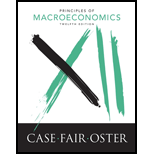
To define inflation and the overall change in price level.
Explanation of Solution
Inflation is defined as a situation in which the general price level of the economy rises continuously. In the given situation there are only three goods in the economy and hence the overall price level can be calculated as the average of the prices of the three items, using the following equation.
The average price in the beginning was $7.33.
It is given that the price of goods changes by the end of the year. The new average index can be calculated as follows,
The average price level by the end of the year is $8. From the calculations it is obvious that the average price level has increased by the end of the year. This is simple method of calculating the overall price level. A better measure of change in price level can be computed if one knows the relative importance or weights of each of these commodities in the consumption basket of individuals.
Concept Introduction:
Inflation: Inflation is defined as a phenomenon in which the overall price level of the economy continues to increase for a period of time. Inflation reduces the
Want to see more full solutions like this?
Chapter 5 Solutions
Principles of Macroeconomics (12th Edition)
- You are now required to compute the consumer price index (CPI) and the inflation in one village. To do this task, you go to that village to collect data of households’ consumption in that village. After collecting data, you find that households in this village consume a standard basket of 3kg of rice, 1.5kg of meat and 3kg of vegetable and the prices of these products are given below: a) CPI in Jan 2017, in Feb 2017, and in Mar 2017 by taking Jan 2017 as the base month.b) Inflation rate from Feb to Mar 2017arrow_forwardSuppose the base year bundle of goods X, Y, and Z is: (X^(b), Y^(b), Z^(b))= (5,700,60) and the base year (vector of) prices is: (Px^(b),Py^(b), Pz^(b))=(1000,5,25) The following year the (vector of) prices is: (Px^(b+1), Py^(b+1), Pz^(b+1))= (1010,5.05,27.50) 1) Compute the inflation using a Laspeyres Price Index, like the original form of the Consumer Price Index(CPI). 2) Compute the inflation index an alternative way. Calculate the price increase for each good separatelyand then take a weighted average of these price increases, using as weights the budget shares spent on eachgood in the base year. For example, for good X use weight Sx^(b)= (Px^(b)X^(b))/(Px^(b)X^(b)+ Py^(b)Y^(b)+Pz^(b)Z^(b)) Please show all work very confusedarrow_forwardAssuming the nominal interest rate is positive, ceteris paribus, which of the following statements is correct? a. If the nominal interest rate is 4 percent and the inflation rate is 3 percent, then the real interest rate is 7 percent. b. When the inflation rate is positive, ceteris paribus, the real interest rate will be less than the nominal interest rate. c. When the inflation rate is zero, ceteris paribus, the nominal interest rate will be less than the real interest rate. d. If the nominal interest rate is 5 percent and the inflation rate is 2 percent, then the real interest rate is -3 percent.arrow_forward
- Suppose that a typical consumer buys the following quantities of three goods and services in 2018 and 2019.Calculate the inflation rate? Commodity Quantity 2010 Unit Price 2018 Unit Price 2019 Unit Price Food 3 units $12.0 $15.0 $18.0 Shelter 2 units $20.0 $30.0 $32.0arrow_forwardIf the nominal interest rate is 10 percent and the real interest rate is 5 percent, the inflation rate is 5 percent. 10 percent. 15 percent. 2 percent.arrow_forwardSuppose the annual nominal interest rate on bank certificate of deposit is 12%. How much is the real interest rate if the inflation rate is 13%?arrow_forward




 Economics (MindTap Course List)EconomicsISBN:9781337617383Author:Roger A. ArnoldPublisher:Cengage Learning
Economics (MindTap Course List)EconomicsISBN:9781337617383Author:Roger A. ArnoldPublisher:Cengage Learning Exploring EconomicsEconomicsISBN:9781544336329Author:Robert L. SextonPublisher:SAGE Publications, Inc
Exploring EconomicsEconomicsISBN:9781544336329Author:Robert L. SextonPublisher:SAGE Publications, Inc





